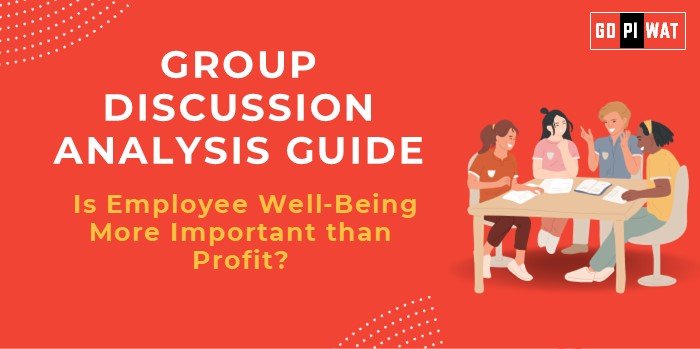📋 Group Discussion (GD) Analysis Guide: Is Employee Well-Being More Important than Profit?
🌐 Introduction to the Topic
- Opening Context: In today’s fast-paced corporate world, companies increasingly recognize that prioritizing employee well-being can lead to sustainable business success. This question raises a critical dilemma: Is achieving profit possible without ensuring employee well-being?
- Topic Background: While traditional business models often prioritized profit as the ultimate goal, modern organizations are shifting towards people-centric approaches. Global movements such as the Great Resignation and emphasis on mental health have amplified the need to balance profits with employee welfare.
📊 Quick Facts and Key Statistics
- 💰 Mental Health Costs: The global economy loses $1 trillion annually due to productivity loss from mental health issues (WHO).
- 📈 Productivity Link: Companies with high employee well-being report a 21% increase in productivity and 37% lower absenteeism (Gallup).
- 🔄 Retention Impact: 57% of employees leave their jobs due to lack of support for well-being (Glassdoor).
- 💵 Profit Gains: Companies that prioritize well-being outperform their peers by 10-15% in profitability over five years (Harvard Business Review).
🌟 Stakeholders and Their Roles
- 🏢 Corporations: Responsible for balancing profitability with holistic employee well-being policies (e.g., flexible work hours, mental health initiatives).
- 👩💼 Employees: Active contributors to productivity; demand better mental health support, work-life balance, and fair treatment.
- 💸 Investors: Balancing short-term financial gains with sustainable, people-focused strategies for long-term value.
- 🏛️ Government/Policy Makers: Setting regulations and frameworks for employee welfare (e.g., labor laws, workplace safety).
🏆 Achievements and Challenges
Achievements
- ✔️ Enhanced Productivity: Google and Microsoft introduced well-being initiatives like mental health days and saw significant boosts in employee performance.
- 🔄 Lower Turnover Rates: Patagonia’s focus on work-life balance resulted in 25% lower turnover than industry standards.
- 📊 Economic Benefits: Studies show happy employees generate 13% more profits annually than disengaged ones (Oxford Study).
Challenges
- ⚠️ Profit Pressures: Many companies, especially small businesses, prioritize short-term profits over long-term investments in employee welfare.
- 🌍 Global Comparisons: Scandinavian countries like Sweden prioritize employee well-being with shorter workweeks, yet achieve strong economic outputs. Comparatively, companies in the US often struggle with burnout and high turnover.
Case Studies
- 🎥 Netflix: Offers unlimited vacation time and strong mental health support, resulting in improved retention and creativity.
- 🇯🇵 Japan’s Karoshi Crisis: Overworking culture led to major societal challenges and forced policy reforms.
📚 Structured Arguments for Discussion
- 🟢 Supporting Stance: “Companies that prioritize employee well-being see a direct impact on performance, innovation, and retention, proving that profits follow happy employees.”
- 🔴 Opposing Stance: “Focusing excessively on employee well-being may divert resources and reduce competitiveness, especially for small businesses facing tight margins.”
- ⚖️ Balanced Perspective: “While profit is essential for sustainability, a focus on employee well-being ensures long-term profitability, loyalty, and organizational growth.”
💡 Effective Discussion Approaches
- Opening Approaches:
- 📊 Statistical Approach: “With businesses losing $1 trillion annually to mental health-related productivity drops, ignoring employee well-being can be financially detrimental.”
- 📖 Case-Based: “Companies like Netflix and Patagonia have shown that investing in employees directly enhances organizational success.”
- Counter-Argument Handling:
“While short-term profits may require cost-cutting, investing in employee well-being reduces attrition and boosts productivity, making it a financially sound decision long-term.”
📊 Strategic Analysis of Strengths and Weaknesses
- 🌟 Strengths: Improves productivity and innovation; reduces attrition and absenteeism.
- ⚠️ Weaknesses: High initial investment cost; immediate profit delays for small firms.
- 📈 Opportunities: Enhanced employer branding to attract top talent; tech solutions for remote work and health support.
- ⚡ Threats: Global competition prioritizing cost-efficiency; economic downturns forcing resource cuts.
🎓 Connecting with B-School Applications
- 📈 Real-World Applications: Employee well-being connects with HR management, corporate strategy, and sustainable business practices.
- 📋 Sample Interview Questions:
- “How can businesses balance profitability with employee welfare?”
- “Provide examples of organizations where employee-centric policies have driven success.”
- 💡 Insights for Students: Future leaders must view human capital as a long-term investment for corporate success.


